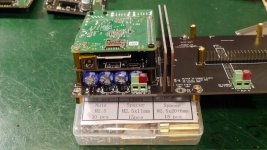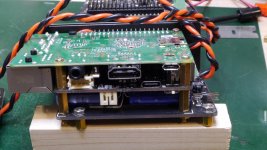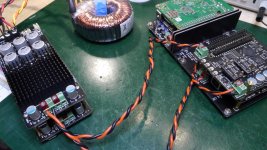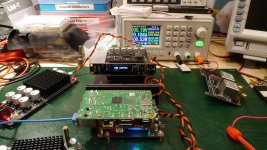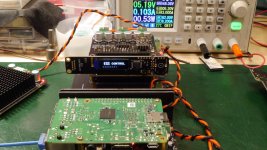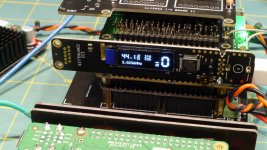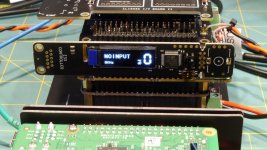That's exactly what I did. Here's a quick rundown on what's inside mine I profiled in another thread. I know I was onto something when my son came down and couldn't believe what he was hearing. I trust his young, 22yr old ears to my 'aging' ones for validation of what sounds good.....Up to a certain pricepoint we use the same technology DAC, but we have the freedom to dramatically overspec power supplies, clocks and output stages as we voice our DAC.....
i'm not sure about ESS sounding forward as a general statement. Agreed with Luca72c it depends greatly on the output stage circuit and this was confirmed by a rather extensive collaborative search for what was in the end rather a small hump in the response (IMD), under ill suited loading conditions.
That being said, the RME ADI-2 is a superb unit and I would say if you are still finding your system not to your liking, the problem likely resides somewhere else, other than your DAC.
That being said, the RME ADI-2 is a superb unit and I would say if you are still finding your system not to your liking, the problem likely resides somewhere else, other than your DAC.
My system sounds good, but I would prefer a little more laid back presentation. RME DAC + NC500 (with SI op-amps) and forward speakers means the sound becomes a little analytical and forward. I have pure OCC copper for all cables (homemade), no silver, so cables are tweaked as good as they can.
But maybe a better first step would be to try Sparkos op-amps instead for the NC500.
But maybe a better first step would be to try Sparkos op-amps instead for the NC500.
I'm not expert about Hypex amps, but surely there are many ways to act in the direction you want; usually for this kind of problems, acting upstream is preferable, unless a certain problem is identified downstream.
Going Sparkos could be a solution worth trying, or even using a tube buffer for NC500 (much more expensive and complicated, unfortunately).
Maybe the easiest solution could be acting on software level, using something like HQPlayer and carefully choosing filters/modulators/eq setup/convolution adjustments...
Going Sparkos could be a solution worth trying, or even using a tube buffer for NC500 (much more expensive and complicated, unfortunately).
Maybe the easiest solution could be acting on software level, using something like HQPlayer and carefully choosing filters/modulators/eq setup/convolution adjustments...
Cheers, I am using HQPlayer and up-sampling to DSD256 + ASMD7EC (which seems to give a more solid soundstage and better sound in general). It also might turn out that if I go for a more laid back sound I will miss the analytical sound to much.
Tube op-amps would be nice to at least try, but the only one I found cost more than NC500 monoblocks I use
Link: Buffer Korg Nutube for Hypex NC500 and Purifi Audio 1ET400 (V2) |
Tube op-amps would be nice to at least try, but the only one I found cost more than NC500 monoblocks I use
Link: Buffer Korg Nutube for Hypex NC500 and Purifi Audio 1ET400 (V2) |
Is the Pi capable of native DSD output ? . I believe the Beaglebone is able to do it with Botic drivers
@lindamar
Rpi does support the native DSD output but only from a USB streamer. That means if you want to play native DSD on it, you have to connect a USB interface, such as an Amanero Combo384, to the RPi. You will need a BridgePi in this case to include that USB into the stack.
RPi GPIO can only output I2S and DoP, that's the problem of the Linux core. Just hope they can fix it soon.
Ian
that's true ,we know that there is some fq lift in ess out filter....ESS dacs sounding warmer and smoother than AKM dacs too, only difference were a few components in the output stage.
what type you use ?current or voltage ,iron ,opa ,jfet tube?
tnx
Hello tnx, i currently use a (mostly) I/V tube output stage (with gain), in which one of the most important part is a reconstruction low pass 2nd order filter around 31/32 khz. The filter is of primary importance, just a few khz more will ruin the sound of the dac. I/V resistors type/model is very very important for dac sound, too.
I'm very convinced by Bisesik's transformers, but i don't want to loose the "tube rolling" part of the entertainment... I'll use them in my next dac
I'm very convinced by Bisesik's transformers, but i don't want to loose the "tube rolling" part of the entertainment... I'll use them in my next dac
Ian Stack Version 2
Hello all -
I'm in the testing mode of my 'Version 2' of Ian's DAC stack using a variety of new boards from Ian.
I thought I would base it around the new StationPi that makes hooking everything up a bit easier. As can be seen in the pictures, per Ian's recommendation I'm using the ConditionerPi under the RPi left side of the StationPi. This side is being powered by a singe 5v LinearPi PSU.
On the right side of the 'Station' I've fitted the BridgePi, the FiFoPi Q3, the dual ES DAC, and finally there will be some output stage(either xformer, or opamp). Haven't decided yet.
At the moment, I'm powering the FiFoPi from a single 3.3v regulator fitted on the ConditionerPi (cannot be seen in the pictures). I'm also using a single LinearPi 3.3v PSU for the 3 DAC voltages(this is just for testing). I've got a bench supply supplying the 5V audio connection. This powers the little controller and screen. I have not upgraded any clocks and using the setup in async mode for testing.
I'm running the latest release of Ropieee as my end-point that boots fine and can be seen in roon.
Here's my issue, which I've seen before. I'm getting the dreaded ....ESS Controller.... message displayed instead of No Input as it should. I've checked all my voltages and everything appears secure. Checked all my GPIO connections and everything seems to be in order, all pins mating correctly - with nothing obvious standing out in error.
I'm getting the dreaded ....ESS Controller.... message displayed instead of No Input as it should. I've checked all my voltages and everything appears secure. Checked all my GPIO connections and everything seems to be in order, all pins mating correctly - with nothing obvious standing out in error.
Before I start dismantling the stacking and adding everything one-by-one to try and troubleshoot it, I'd thought I would first touch base here for experienced input from the group and Ian.
Hello all -
I'm in the testing mode of my 'Version 2' of Ian's DAC stack using a variety of new boards from Ian.
I thought I would base it around the new StationPi that makes hooking everything up a bit easier. As can be seen in the pictures, per Ian's recommendation I'm using the ConditionerPi under the RPi left side of the StationPi. This side is being powered by a singe 5v LinearPi PSU.
On the right side of the 'Station' I've fitted the BridgePi, the FiFoPi Q3, the dual ES DAC, and finally there will be some output stage(either xformer, or opamp). Haven't decided yet.
At the moment, I'm powering the FiFoPi from a single 3.3v regulator fitted on the ConditionerPi (cannot be seen in the pictures). I'm also using a single LinearPi 3.3v PSU for the 3 DAC voltages(this is just for testing). I've got a bench supply supplying the 5V audio connection. This powers the little controller and screen. I have not upgraded any clocks and using the setup in async mode for testing.
I'm running the latest release of Ropieee as my end-point that boots fine and can be seen in roon.
Here's my issue, which I've seen before.
Before I start dismantling the stacking and adding everything one-by-one to try and troubleshoot it, I'd thought I would first touch base here for experienced input from the group and Ian.
Attachments
I get this time to time. I actually returned a Fifo to Ian for him to test and it all proved to work fine. I recently took my 'stack ' apart to change a psu to AVDD.
Low and behold i got the dreaded 'tracking dots' and 'ess controller' . After a few turns off and on it eventually booted fine. I do think it is related to clock signal integrity so maybe check your u.fls and oscillator seating in the fifo. Mine seemed to have no rhyme or reason but it did boot properly after a short time of retrying.
Low and behold i got the dreaded 'tracking dots' and 'ess controller' . After a few turns off and on it eventually booted fine. I do think it is related to clock signal integrity so maybe check your u.fls and oscillator seating in the fifo. Mine seemed to have no rhyme or reason but it did boot properly after a short time of retrying.
Hello all -
I'm in the testing mode of my 'Version 2' of Ian's DAC stack using a variety of new boards from Ian.
I thought I would base it around the new StationPi that makes hooking everything up a bit easier. As can be seen in the pictures, per Ian's recommendation I'm using the ConditionerPi under the RPi left side of the StationPi. This side is being powered by a singe 5v LinearPi PSU.
On the right side of the 'Station' I've fitted the BridgePi, the FiFoPi Q3, the dual ES DAC, and finally there will be some output stage(either xformer, or opamp). Haven't decided yet.
At the moment, I'm powering the FiFoPi from a single 3.3v regulator fitted on the ConditionerPi (cannot be seen in the pictures). I'm also using a single LinearPi 3.3v PSU for the 3 DAC voltages(this is just for testing). I've got a bench supply supplying the 5V audio connection. This powers the little controller and screen. I have not upgraded any clocks and using the setup in async mode for testing.
I'm running the latest release of Ropieee as my end-point that boots fine and can be seen in roon.
Here's my issue, which I've seen before.I'm getting the dreaded ....ESS Controller.... message displayed instead of No Input as it should. I've checked all my voltages and everything appears secure. Checked all my GPIO connections and everything seems to be in order, all pins mating correctly - with nothing obvious standing out in error.
Before I start dismantling the stacking and adding everything one-by-one to try and troubleshoot it, I'd thought I would first touch base here for experienced input from the group and Ian.
@redjr
1. Make sure all of the three 3.3V power rails to the ES9038Q2M DAC are working correctly.
2. Make sure DAC XO is working, otherwise change to AYNC mode by connecting a u.fl cable to FifoPi MCLK.
3. Plug the ESS controller directly to the DAC GPIO to see if it can find the DAC.
Ian
Ian
@Ian,
1. Make sure all of the three 3.3V power rails to the ES9038Q2M DAC are working correctly. Yes. All measure 3.3v. For now anyway, I'm using a single LinearPI strapped for 3.3V.
2. Make sure DAC XO is working, otherwise change to AYNC mode by connecting a u.fl cable to FifoPi MCLK. Whether SYNC mode or standard ASYNC mode, nothing.
3. Plug the ESS controller directly to the DAC GPIO to see if it can find the DAC. No, still nothing.
Question... How does the controller get powered? Through the non-isolated GPIO header? It appears to be able to be powered from the 5V Audio (J5) connector. Or, could it be powered directly from J3 on the FifoPI Q3? Which is preferred.
The FifoPi ppears to recognize signals from roon, as it locks on and different I2S and DSD LEDs light. But nothing on the DAC. I'm perplexed.
1. Make sure all of the three 3.3V power rails to the ES9038Q2M DAC are working correctly. Yes. All measure 3.3v. For now anyway, I'm using a single LinearPI strapped for 3.3V.
2. Make sure DAC XO is working, otherwise change to AYNC mode by connecting a u.fl cable to FifoPi MCLK. Whether SYNC mode or standard ASYNC mode, nothing.
3. Plug the ESS controller directly to the DAC GPIO to see if it can find the DAC. No, still nothing.
Question... How does the controller get powered? Through the non-isolated GPIO header? It appears to be able to be powered from the 5V Audio (J5) connector. Or, could it be powered directly from J3 on the FifoPI Q3? Which is preferred.
The FifoPi ppears to recognize signals from roon, as it locks on and different I2S and DSD LEDs light. But nothing on the DAC. I'm perplexed.
@Ian,
1. Make sure all of the three 3.3V power rails to the ES9038Q2M DAC are working correctly. Yes. All measure 3.3v. For now anyway, I'm using a single LinearPI strapped for 3.3V.
2. Make sure DAC XO is working, otherwise change to AYNC mode by connecting a u.fl cable to FifoPi MCLK. Whether SYNC mode or standard ASYNC mode, nothing.
3. Plug the ESS controller directly to the DAC GPIO to see if it can find the DAC. No, still nothing.
Question... How does the controller get powered? Through the non-isolated GPIO header? It appears to be able to be powered from the 5V Audio (J5) connector. Or, could it be powered directly from J3 on the FifoPI Q3? Which is preferred.
The FifoPi ppears to recognize signals from roon, as it locks on and different I2S and DSD LEDs light. But nothing on the DAC. I'm perplexed.
ESS controller takes power from the non-isolated GPIO.
The problem is that ESS controller did get I2C communication with DAC.
1. Check all pins of the GPIO of the controller
2. Check the soldering of all the power connecter on the DAC.
3. Use the DAC default XO mode, trying to make sure XO has 100MHz output.
Regards,
Ian
Success! Sort of.  It appears it was the RPi. I replaced that and things started coming together. I say started because, I only have it working with the BridgePi, not over the network yet.
It appears it was the RPi. I replaced that and things started coming together. I say started because, I only have it working with the BridgePi, not over the network yet.
I can't get anything to play or even get the FifoPi to 'lock on' when playing from the network. I've tried both Ropieee and roonBridge without success. When using Ropieee, what DAC overlay should I select? I even took the microSD card out of my main Ian stack (roonBridge), put into this new build and still the input on the controller doesn't change, or 'see' anything. And nothing plays. I read through the BridgePi docs and there doesn't appear to be any jumper that needs to be set when not using it. I believe the input is auto-switching? Ideas?
I can't get anything to play or even get the FifoPi to 'lock on' when playing from the network. I've tried both Ropieee and roonBridge without success. When using Ropieee, what DAC overlay should I select? I even took the microSD card out of my main Ian stack (roonBridge), put into this new build and still the input on the controller doesn't change, or 'see' anything. And nothing plays. I read through the BridgePi docs and there doesn't appear to be any jumper that needs to be set when not using it. I believe the input is auto-switching? Ideas?
Attachments
I still can't stream anything over the network. Regardless of the DAC overlay I use in roon(ropieee), I'm still getting the 'NO INPUT' message on the controller display. The I2S and/or Lock LEDs light up accordingly. The only LED lite is the red Empty. What could be causing the controller not seeing anything selected in roon to playback via the network over I2S?
Attachments
- Home
- Source & Line
- PC Based
- IanCanada's Latest RPi GB Goodies Impressions... and your tweaks, mods and hints...
